"A lightweight open-source Python library for exact view-factor computations on polygonal meshes"
Project description
PyViewFactor
pyViewFactoris a lightweight open-source Python library for exact view-factor computations on polygonal meshes.
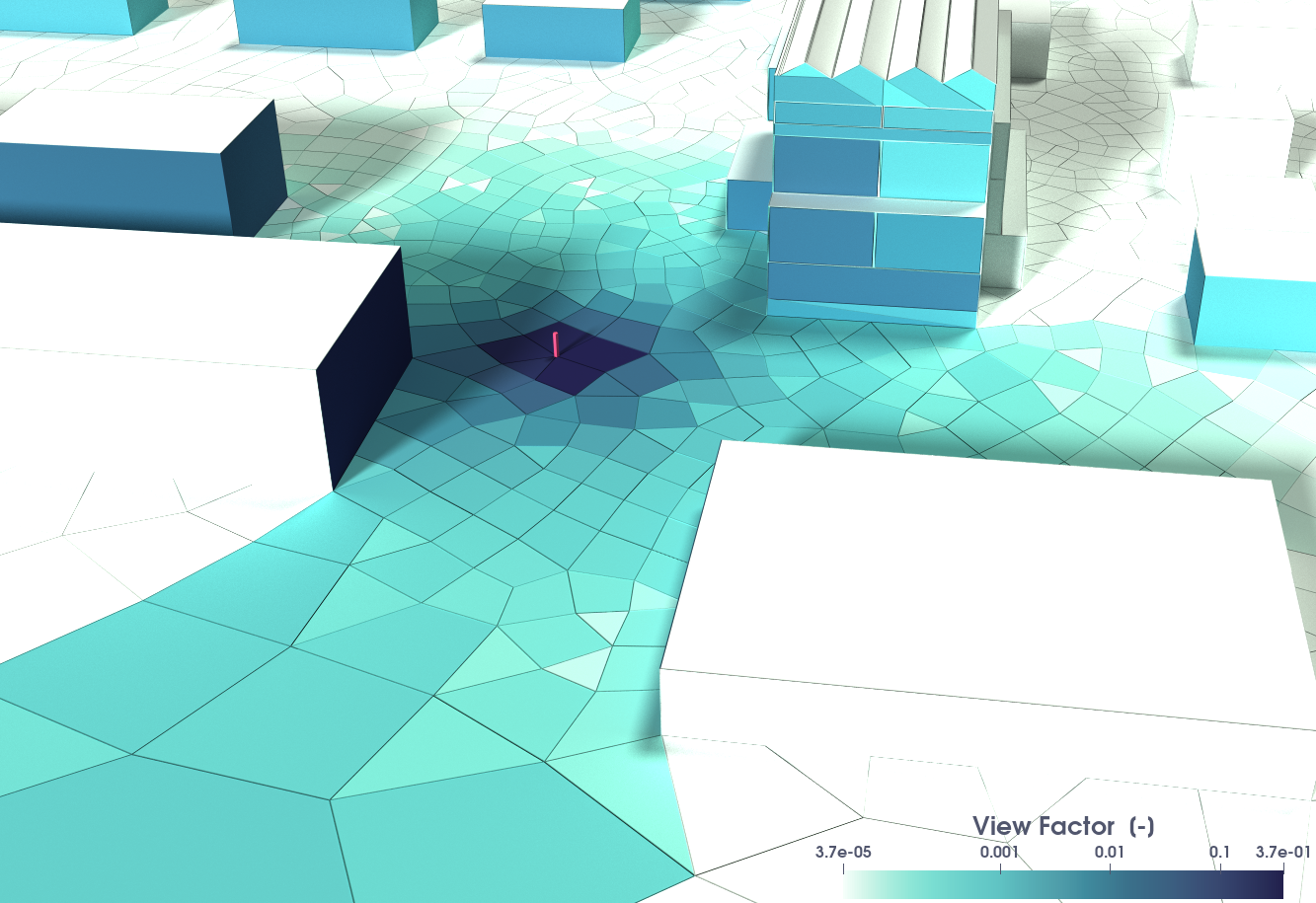
Documentation available here.
Table of Contents
Features
- This library enables the computation of radiation view factors between palanar polygons using an accurate double‐contour integration method described in (Mazumder and Ravishankar 2012) with insights from (Schmid 2016).
- It uses the handy
Pyvistapackage to deal with geometry imports (*.stl,*.vtk,*.obj, ...), geometry creations, and some other mesh functionallities under the hood, - For a given geometry or set of planar faces, with
pyViewFactoryou will able to : [x] Optionally check that the faces can "see" each other withget_visibility(face1, face2, ...), [x] Optionally check that no obstruction lies between them withget_obstruction(face1, face2, obstacle, ...), [x] Compute the view factor fromface2toface1withcompute_view_factor(face1, face2, ...), [x] Compute the view factor matrix for a complete mesh, in parallel 🚀, withcompute_viewfactor_matrix(mesh, ...)!
[!NOTE] All the examples below are provided as
*.pyfiles in the/examples/folder of the repository, with additional usecases.
Quick Start
Suppose we want to compute the radiation view factor between a triangle and a rectangle facing each other:
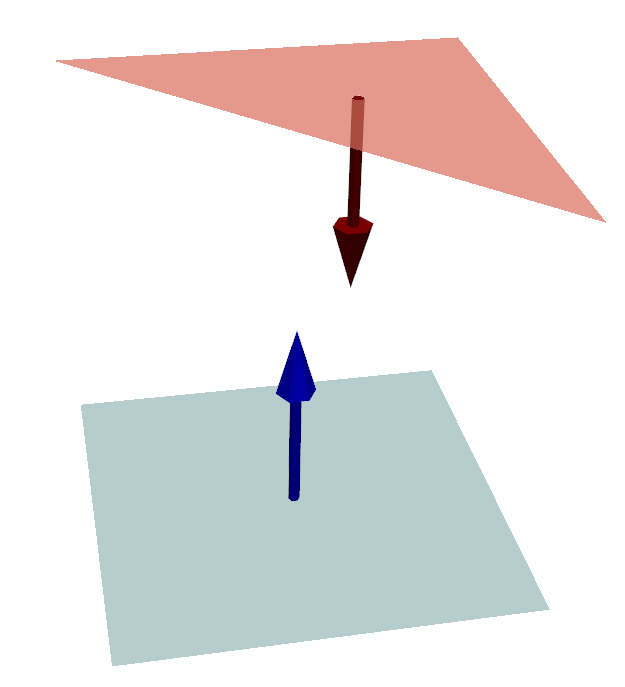
You are few lines of code away from your first view factor computation:
import pyvista as pv
import pyviewfactor as pvf
# Create a rectangle and a triangle facing each other
pointa1 = [0.0, 0.0, 0.0]
pointb1 = [1.0, 0.0, 0.0]
pointc1 = [0.0, 1.0, 0.0]
rectangle = pv.Rectangle([pointa1, pointb1, pointc1])
pointa2 = [0.0, 0.0, 1.0]
pointb2 = [0.0, 1.0, 1.0]
pointc2 = [1.0, 1.0, 1.0]
triangle = pv.Triangle([pointa2, pointb2, pointc2])
if get_visibility(rectangle, triangle):
F = compute_viewfactor(triangle, rectangle)
print("VF from rectangle to triangle :", F)
else:
print("Not facing each other")
pl = pv.Plotter()
pl.add_mesh(rectangle, color="lightblue", opacity=0.7)
pl.add_mesh(triangle, color="salmon", opacity=0.7)
# compute and glyph normals for mesh1
n1 = rectangle.compute_normals(cell_normals=True, point_normals=False)
arrows1 = n1.glyph(orient="Normals", factor=0.1)
pl.add_mesh(arrows1, color="blue")
# similarly for mesh2
n2 = triangle.compute_normals(cell_normals=True, point_normals=False)
arrows2 = n2.glyph(orient="Normals", factor=0.1)
pl.add_mesh(arrows2, color="darkred")
pl.show()
You usually get your geometry from a different format?
(*.dat, *.idf, ...)
Check pyvista's documentation on how to generate a PolyData facet from points.
More Examples
Example with a closed geometry and the VTK file format
We will now compute the view factors within a more complex geometry: a closed sphere (clipped in half below), with inwards facing normals, so the faces can "see" each other. Note that the face-to-face visibility is unobstructed (for obstructed geometries, see next section).
The field of view factors from one facet to all others will be computed and stored in
a .vtk file, which you can explore with the open source
Paraview software.
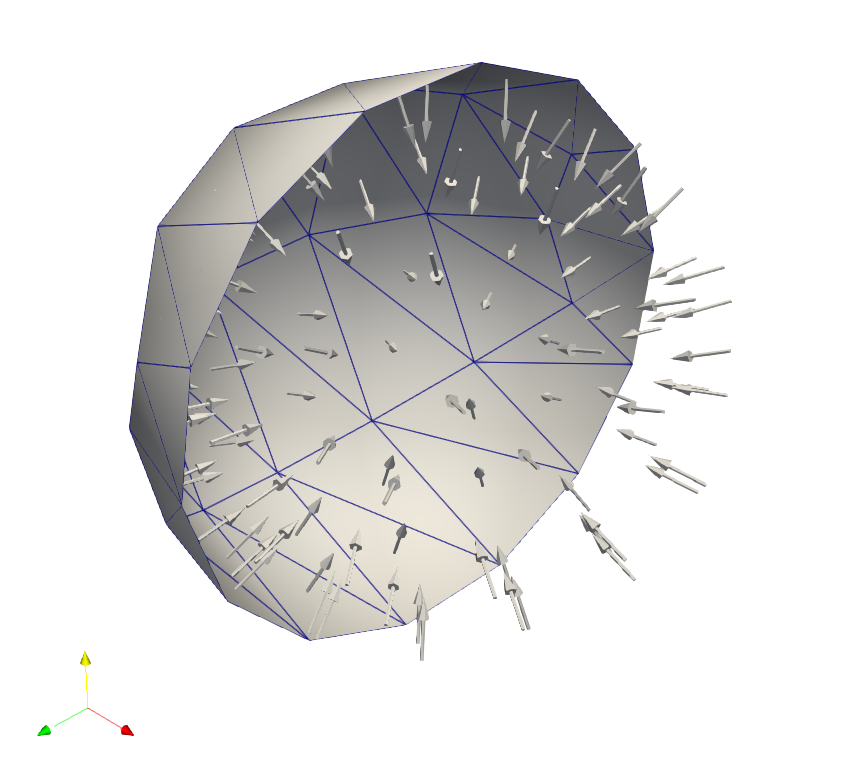
The following snippet can be reused as a kick-start for your own purposes:
import pyvista as pv
import numpy as np
import pyviewfactor as pvf
sphere = pv.Sphere(radius=10, center=(0, 0, 0), direction=(0, 0, 1),
theta_resolution=8, phi_resolution=8,
start_theta=0, end_theta=360,
start_phi=0, end_phi=180)
# triangulate
sphere.triangulate(inplace=True)
# and put the normals inwards please
# sphere.flip_faces(inplace=True)
# let us chose a cell to compute view factors to
cell_extracted_id = 2
# let us chose a cell to compute view factors to
chosen_face = sphere.extract_cells(cell_extracted_id)
# convert to PolyData
chosen_face = pvf.fc_unstruc2poly(chosen_face)
# "one array to contain them all"
F = np.zeros(sphere.n_cells)
# now let us compute the view factor to all other faces in a sequential way
for i in range(sphere.n_cells):
if i != cell_extracted_id:
face = sphere.extract_cells(i) # other facet
face = pvf.fc_unstruc2poly(face) # convert to PolyData
if pvf.get_visibility(face, chosen_face):
# compute VF
F[i] = pvf.compute_viewfactor(face,
chosen_face,
epsilon=0.00001,
rounding_decimal=7)
else:
print("Problem, all cells should see each other.")
print("Sum check: \n (is Sum_i^n F_i =? 1)", np.sum(F))
# put the scalar values in the geometry
sphere.cell_data["F"] = F
sphere.save("./sphere.vtk") # ... and save.
# let us have a look in 3D with an interactive window...
pl = pv.Plotter() # instantiate 3D window
pl.add_mesh(sphere, scalars="VF1", cmap="jet") # add mesh with a nice color scheme
outline = chosen_face.outline() # gives you just the wireframe of that cell
pl.add_mesh(
outline,
color="red", # pick a contrasting color
line_width=3.0, # thicker line so it stands out
pickable=False
)
pl.show()
# Alternatively, you can compute the full VF matrix rather easily :
# Computation of the Fij matrix in parallel
F = pvf.compute_viewfactor_matrix(
sphere,
skip_visibility=True,
skip_obstruction=True,
compute_kwargs={"epsilon": 1e-4, "rounding_decimal": 8},
n_jobs=4
)
# We can do the same check as previously for the extracted cell
print("Sum check: \n (is Sum_i^n F_i =? 1)", cell_extracted_id,
"=", F[:, cell_extracted_id].sum())
The results look as per following images showing the view factor from the chosen cell to all others.
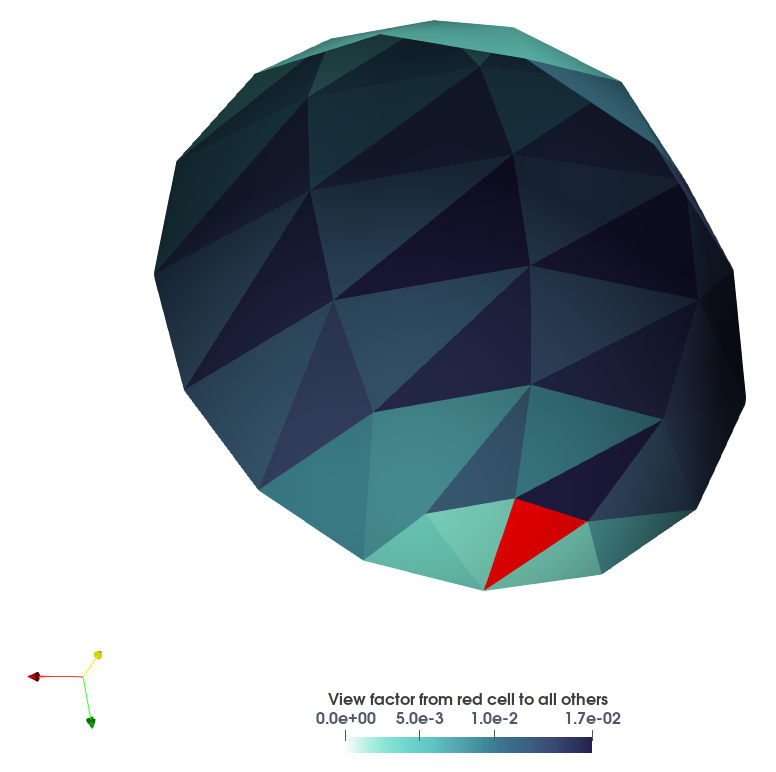
View factors of an individual with a wall
For comfort computations, it may be useful to determine heat transfer between an invidivual and a wall. We will use here PyVista's doorman example as a basis for the human geometry.
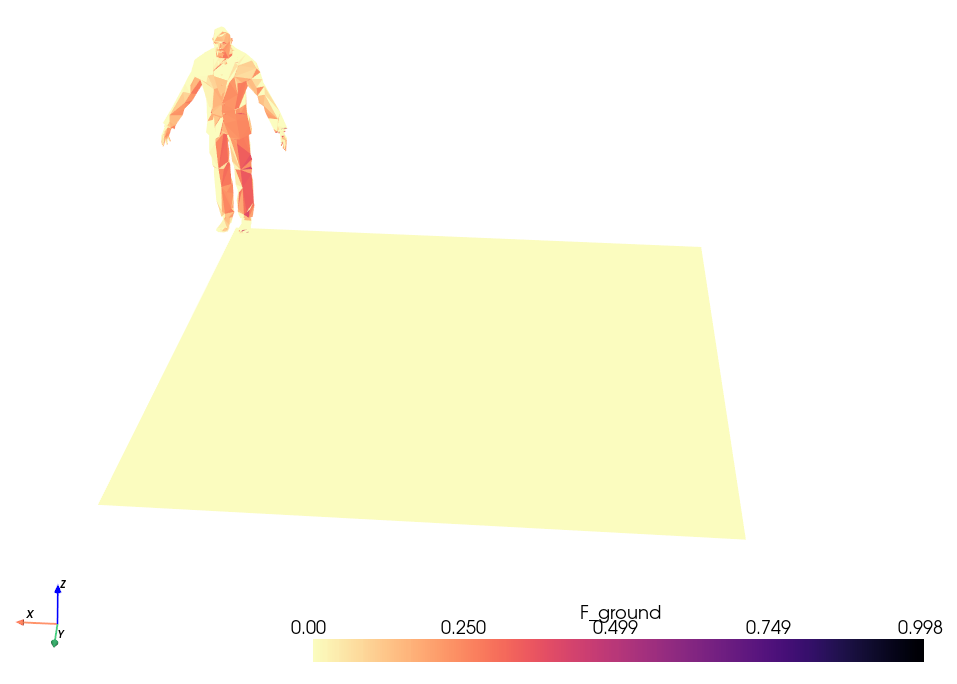
The following code and .vtk file of the doorman example are available in
the ./examples/ folder.
from tqdm import tqdm
import numpy as np
import pyvista as pv
import pyviewfactor as pvf
def fc_Fwall(nom_vtk):
# This function is bit more generic than this specific use case,
# so it can be reused for other applications
mesh = pv.read(nom_vtk)
# find all types of walls : in this example only a ground
wall_types = list(np.unique(mesh["geom_id"]))
# remove the individual from the list (still named "cylinder"...)
wall_types.remove("doorman")
# where is the doorman in the list?
index_doorman = np.where(mesh["geom_id"] == "doorman")[0]
# prepare storage for the different walls in a dict
dict_F = {}
# loop over wall types
for type_wall in wall_types:
# prepare for storing doorman to wall view factor
F = np.zeros(mesh.n_cells)
# get the indices of this type of wall
indices = np.where(mesh["geom_id"] == type_wall)[0]
# loop over
for i in indices:
wall = mesh.extract_cells(i)
wall = pvf.fc_unstruc2poly(wall) # convert for normals
# ... for each facet of the individual
for idx in tqdm(index_doorman):
face = mesh.extract_cells(idx)
face = pvf.fc_unstruc2poly(face) # convert for normals
# check if faces can "see" each other
if pvf.get_visibility(wall, face):
# compute face2wall view factor
Ffp = pvf.compute_viewfactor(wall, face)
else:
Ffp = 0
F[idx] = Ffp
# store array F in e.g. dict_F["F_ceiling"]
dict_F["F_" + type_wall.replace("\r", "")] = F
return dict_F
# You can get the doorman geomtry it directly from here:
# https://gitlab.com/arep-dev/pyViewFactor/-/blob/main/examples/example_doorman_clean.vtk
# ... or get it from this repository's examples
file = "./src_data/example_doorman_clean.vtk"
# compute the VFs for the doorman to the different wall types in the scene
dict_F = fc_Fwall(file)
# re-read and store
mesh = pv.read(file)
# loop over what is in the dictionary of view factors
for elt in dict_F.keys():
mesh[elt.replace("\r", "")] = dict_F[elt] # name the field
mesh.save("./src_data/example_doorman_VFground.vtk") # store in the intial VTK
# have a look without paraview with fancy colors
mesh.plot(cmap="magma_r", lighting=False)
More details and view factors abacuses can be found here.
If you find the computation time a bit lengthy ⌛:
- You can use the
compute_viewfactor_matrix()function that leveragesjoblibwith a built-inn_jobsargument 🚀, - More generally, you can learn how to go parallel here!.
Computing the view factors of a wall in its built environment
For building simulation purposes, it may prove to be useful to compute the ground and sky view factors of a given wall, or the view factor of the wall to other walls in the built environment. In following example (available in the /examples/ folder), we compute the view factors of the environment of the purple wall depicted below.
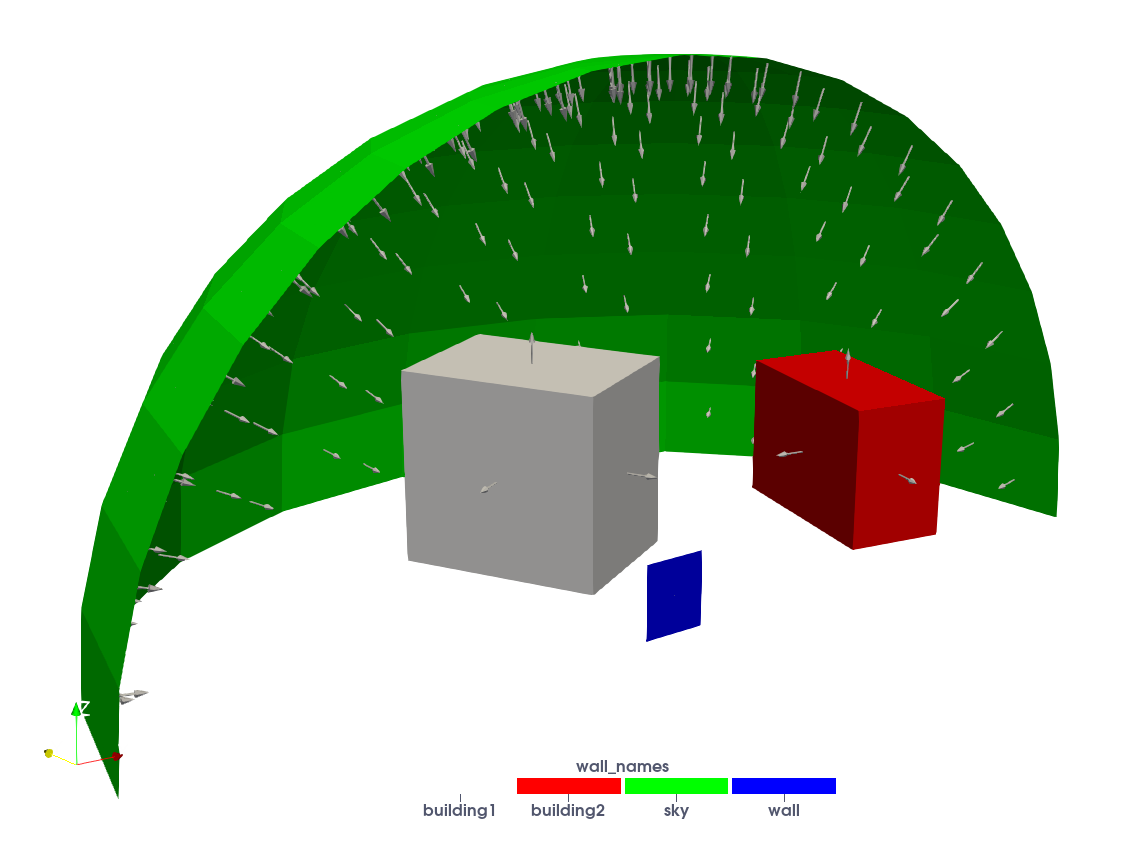
# Read the geometry
mesh = pv.read("./src_data/built_envmt.vtk")
meshpoly = pvf.fc_unstruc2poly(mesh) # convert to polydata for obstruction check
# identify who is who
i_wall = np.where(mesh["wall_names"] == "wall")[0]
i_sky = np.where(mesh["wall_names"] == "sky")[0]
i_building1 = np.where(mesh["wall_names"] == "building1")[0]
i_building2 = np.where(mesh["wall_names"] == "building2")[0]
# get the different elements
wall = mesh.extract_cells(i_wall)
sky = mesh.extract_cells(i_sky)
building1 = mesh.extract_cells(i_building1)
building2 = mesh.extract_cells(i_building2)
# convert to polydata
wall = pvf.fc_unstruc2poly(wall)
# Initialize the View Factor
Fsky = 0
# for all cells constituting the ensemble
for patch in tqdm(i_sky):
sky = mesh.extract_cells(patch) # extract one cell
sky = pvf.fc_unstruc2poly(sky) # convert to polydata
if pvf.get_visibility(sky, wall, strict=True):
if pvf.get_obstruction(sky, wall, meshpoly, strict=True):
# compute and increment view factor :
# F_i->(j+k) = F_i->j + F_i->k
Fsky += pvf.compute_viewfactor(sky, wall)
# same for building 1
Fbuilding1 = 0
for patch in tqdm(i_building1):
bldng1 = mesh.extract_cells(patch)
bldng1 = pvf.fc_unstruc2poly(bldng1)
if pvf.get_visibility(bldng1, wall):
if pvf.get_obstruction(bldng1, wall, meshpoly):
Fbuilding1 += pvf.compute_viewfactor(bldng1, wall)
# same for building 2
Fbuilding2 = 0
for patch in tqdm(i_building2):
bldng2 = mesh.extract_cells(patch)
bldng2 = pvf.fc_unstruc2poly(bldng2)
if pvf.get_visibility(bldng2, wall):
if pvf.get_obstruction(bldng2, wall, meshpoly):
Fbuilding2 += pvf.compute_viewfactor(bldng2, wall)
# complementarity implies \sigma F_i = 1 : compute viewfactor to ground
Fground = 1 - Fbuilding1 - Fbuilding2 - Fsky
# Print results
print("\n-----------------------------")
print("Wall to Sky view factor:")
print("\tSky ", round(Fsky, 4))
print("Wall to Buildings view factors:")
print("\tBuilding 1 ", round(Fbuilding1, 4))
print("\tBuilding 2 ", round(Fbuilding2, 4))
print("Ground view factor:")
print("\tGround ", round(Fground, 4))
The code yields following view factors :
F_{\text{sky}} = 0.345 \\
F_{\text{ground}} = 0.373 \\
F_{\text{building1}} = 0.251 \\
F_{\text{building2}} = 0.031 \\
Understanding the obstruction check function
In real life problems, obstacles may well hinder the radiation heat transfer between surfaces. We thus provide a function to perform obstruction tests, as per following example.
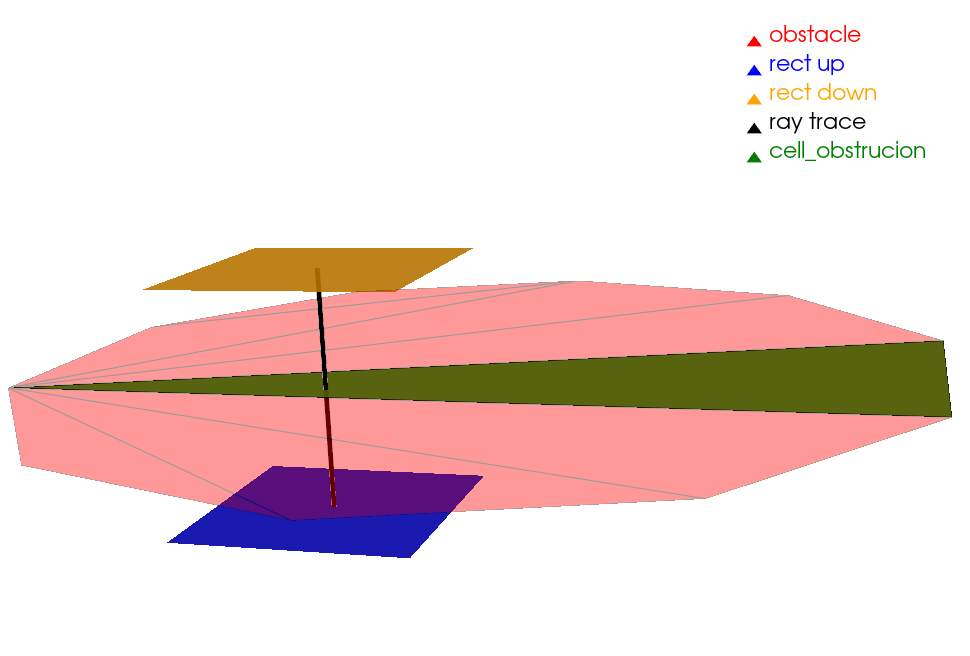
The code snippet below shows how the function get_obstruction() works and allows to understand its usage.
import pyvista as pv
import pyviewfactor as pvf
# let us first create two rectangles
pointa = [0.0, 0.0, 0.0]
pointb = [1.0, 0.0, 0.0]
pointc = [0.0, 1.0, 0.0]
rectangle_down = pv.Rectangle([pointa, pointb, pointc])
pointa = [0.0, 0.0, 1.0]
pointb = [0.0, 1.0, 1.0]
pointc = [1.0, 0.0, 1.0]
rectangle_up = pv.Rectangle([pointa, pointb, pointc])
# a circle will be the obstruction
z_translation, r = 0.5, 2
obstacle = pv.Circle(radius=r, resolution=10)
obstacle.triangulate(inplace=True)
# we translate the obstruction right between both rectangles
obstacle.translate([0, 0, z_translation], inplace=True)
# Define line segment
start = rectangle_down.cell_centers().points[0]
stop = rectangle_up.cell_centers().points[0]
# Perform ray trace
# points, ind = obstacle.ray_trace(start, stop)
# Create geometry to represent ray trace
ray = pv.Line(start, stop)
# Now we can use the get_obtruction function, to check for the obstruction,
# and see each cell of the obstruction mesh is in the way.
obstruction_cell = []
for idx in range(obstacle.n_cells):
obs = obstacle.get_cell(idx).cast_to_polydata()
visible = pvf.get_obstruction(rectangle_down, rectangle_up, obs,
strict=False, print_debug=False)
if not visible[0]:
print("Cell {} of the obstactle is in the way of the".format(idx)
+ "centroids of rectangle_up and rectangle_down")
obstruction_cell.append(idx)
obs = obstacle.extract_cells(obstruction_cell)
# if any intersection
if obs.n_cells > 0:
p = pv.Plotter()
p.add_mesh(obstacle, show_edges=True, opacity=0.4, color="red",
lighting=False, label="obstacle")
p.add_mesh(rectangle_up, color="blue", line_width=5, opacity=0.9,
label="rect up")
p.add_mesh(rectangle_down, color="orange", line_width=5, opacity=0.9,
label="rect down")
p.add_mesh(ray, color="black", line_width=5, label="ray trace")
p.add_mesh(obs, show_edges=True, opacity=0.9, color="green", lighting=False,
label="cell_obstrucion")
p.add_legend()
p.show()
Installation
pyViewFactor can be installed from PyPi using pip on Python >= 3.10:
pip install pyviewfactor
You can also visit PyPi or Gitlab to download the sources.
Requirements:
numpy==1.26.4
pyvista==0.45
scipy==1.11.4
numba==0.61.2
joblib==1.2.0
tqdm==4.65.0
The code will probably work with lower versions of the required packages, however this has not been tested.
[!NOTE] If you are alergic to
numba, you maypip install pyviewfactor==0.0.10that works (and give up the times 3+ speed-up in view factor computation).
Citation & Acknowledgments
- Main contributors:
- Mateusz BOGDAN,
- Edouard WALTHER.
- Acknowledgment: The authors would like to acknowledge M. Alecian for his initial work on the quadrature code and M. Chapon for her contribution to the code validation.
There is even a conference paper, showing analytical validations.
So if you use pyViewFactor in your work, please cite:
[!IMPORTANT] Citation: Mateusz BOGDAN, Edouard WALTHER, Marc ALECIAN and Mina CHAPON. Calcul des facteurs de forme entre polygones - Application à la thermique urbaine et aux études de confort. IBPSA France 2022, Châlons-en-Champagne.
Bibtex entry:
@inproceedings{pyViewFactor22bogdan,
authors = "Mateusz BOGDAN and Edouard WALTHER and Marc ALECIAN and Mina CHAPON",
title = "Calcul des facteurs de forme entre polygones - Application à la thermique urbaine et aux études de confort",
year = "2022",
organization = "IBPSA France",
venue = "Châlons-en-Champagne, France"
note = "IBPSA France 2022",
}
License
MIT License - Copyright (c) AREP 2025
Project details
Release history Release notifications | RSS feed
Download files
Download the file for your platform. If you're not sure which to choose, learn more about installing packages.
Source Distributions
Built Distribution
File details
Details for the file pyviewfactor-1.0.0-py3-none-any.whl.
File metadata
- Download URL: pyviewfactor-1.0.0-py3-none-any.whl
- Upload date:
- Size: 175.1 kB
- Tags: Python 3
- Uploaded using Trusted Publishing? No
- Uploaded via: twine/6.1.0 CPython/3.11.7
File hashes
| Algorithm | Hash digest | |
|---|---|---|
| SHA256 |
91507a1e88072e36a75658f55d35a613a0da3e91c70904d5f73a198d659ff2db
|
|
| MD5 |
fcc6084a65af690939db291fd6c8c9e6
|
|
| BLAKE2b-256 |
0a9db71d572966bdc28230747dd1e5de56c580a98aba103a36316ff213724617
|
















